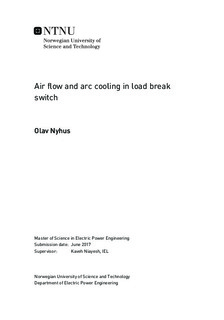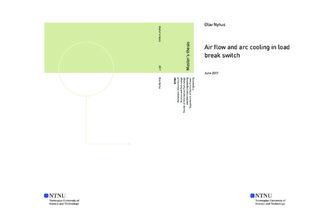| dc.description.abstract | Current interruption is a complex process, and optimizing the design of a medium voltage load-break switch is difficult. The dominating technology for load-break switches in medium voltage switchgear is using SF6 as interruption medium. SF6 is classified as a potent greenhouse gas with very high global warming potential. Thus, the industry has begun looking at other technologies. One interesting option is to quench the arc using air. When using air instead of SF6, optimization with regard to size is important since larger equipment will not fit in many existing installation sites. Due to the superior properties of SF6, little research has been done with air as an interrupting medium in load-break switches.
The thesis addresses medium-voltage load current interruption in air. The project work has focused on determining how the air flow should be designed to obtain the best interruption performance in a load-break switch. A simplified experimental setup based on steady-state air flow and with an electrically heated wolfram wire, simulating the arc, was used. Two different air flow designs were made and tested in the laboratory: axial and radial flow.
With the axial design, the air flow was blown straight on the wire. With the radial design, the air flow was blown 90° onto the wire. Two different wire diameters for the simulated arc were tested to simulate the arc, 0.15 and 0.38 mm. The radial design proved to be 35 % more efficient with a starting temperature of 570°C over the heated were. Laboratory experiments showed that the difference between the axial and radial design increased with temperature. With the radial design, a higher velocity of the air flow was created towards the center of the nozzle. The results show the importance of the angle when air flow is blown on an arc.
By heat distribution measurements, calculations of the convection loss over the heated wire during the cooling process were done. The convection loss increased with stepwise air flow and proved to be dependent on the air flow. The results verified the validation of the model. Hence, the convection loss can describe the efficiency of the cooling for the setup.
Simulations in COMSOL Multiphysics proved to be a good comparison to the laboratory experiments and a deeper picture of the heat distribution was analyzed. A good simulation model of the axial flow was obtained. Making a simulation model of the radial flow turned out to be more complex, but some results indicate the creation of turbulent flow with the radial design. | |

